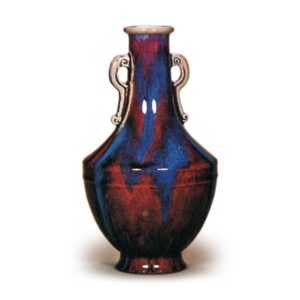
A type of colored glaze used for porcelain with a blood-red color.
It has been produced in China since ancient times, and was also followed in Korea and Japan. The name “cinnabar glaze” is probably derived from the color of cinnabar, a natural red color made from mercury sulfide. The main substance used to produce this blood-red color is a copper compound, which is mixed with a weak porcelain glaze and fired in a reducing furnace.
Chinese cinnabar handles (known as “underglaze red”), such as those from the Jiyuhongro kiln, Lohyun glazed ware, and Sekihong, came from a lineage of red-purple glazes known as the Song-gyun kiln. During the Xuande period of the Ming dynasty (1426-1355), there was an invention of Jiyuhong, which was called “festival red” or “jewel red,” and had a bright, subdued red tone with a very elegant glaze. This ceremonial red glaze was called “rite red” or “jewel red,” and was very elegant. It was not until the Kangxi period (1662-1722) of the Qing dynasty that the Rang kiln hand, which is said to have “begun and ended at Kangxi,” appeared. Its crimson-colored porcelain is as red as chicken blood or cow’s blood. In the Yongzheng period (1723-35), the Rongjun glaze was created, and its crimson-purple glaze tone was reminiscent of the crimson-purple color of Songjun ware, but with a brighter hue. In Japan, this was called cinnabar kiln-hen or simply kiln-hen, and was highly prized. It is difficult to explain the difference in color between cinnabar and cinnabar-kiln varnish, but the process of making cinnabar-kiln varnish is different. Although there are some exceptions, Chinese porcelain generally does not undergo the unglazing process, but is glazed and fired immediately on the raw base, and Jyuhongte and Rangyote are examples of this unglazing process. In this case, the firing process requires a great deal of effort to control the heat, and it is quite difficult to obtain the beautiful coloring of cinnabar glaze. However, if the piece is fired once before glazing and then covered with cinnabar glaze and fired again, it is easy to obtain a beautiful red cinnabar hand, which in Jingdezhen and other areas is called Sekihongte.
This type of ware generally exhibits a red color without fail and there seems to be little kiln alteration, but there is a sense of lack of harmony between the body and the glaze. In addition to the “Kwangtoro” type, there is a cinnabar type commonly known as “Kwangtoro” kiln. It is a yellowish-brown stoneware body covered with a cinnabar glaze, and its color is more like vermillion red than crimson, giving it a somewhat vulgar appearance. The color change in the cinnabar glaze, or kiln alteration, is as prized as the crimson color. The greenish variant is called shohin-green or apple green, and is extremely expensive. Cinnabar handles that are azuki red are called mohong (bean red), and those with a light red color are called peach blossom pieces, or peach bloom as the English call them, which also have a market price. Grayish ones are called milk-rat skin, and are appreciated by the sukiya. Korean Yi Dynasty cinnabar handles are called “crimson saucers,” “red dot saucers,” and “red saucers. There are few examples of Japanese cinnabar handles. In recent years, it has become known that some of Arita’s early works were white porcelain decorated with cinnabar, but they are not excellent works, and there are not many of them.



